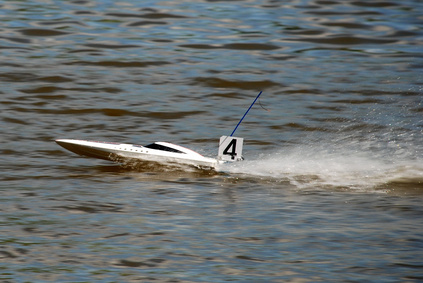
Sir William Hamilton designed the water jet system in 1954. The design provided safer shallow water cruising by passing over rocks and mud in shallow rivers and estuaries. The design of the jet boat survives today, made by several manufacturers. Unlike the prop boat, the jet boat uses a high-pressure jet of water ejected from the transom of the craft to propel it through the water. Although modifications to the jet boat design exist today, problems still occur with the concept of propelling a boat by high-pressurized water.
Most of the jet boats built today operate on the smaller recreational craft seen in rivers, lakes and estuaries. The bottom profiles of the jet boats possess flatter contours that produce less drag, allowing them to get up on a plane much faster. Jet boat drives do not have enough pulling power for the larger recreational vessels, nor do they have the ability to reach the higher speeds required for cruising. The deep V hulls of the larger vessels limit the capability of the jet boat to overcome drag.
The handling characteristics of jet boats have less effectiveness during low-speed throttle conditions. Propeller-driven watercraft respond faster because the propeller blades offer more "bite" in the water. A jet boat's maneuverability falls off sharply during engine idle or low-speed cruising, even though the jet nozzle swivels in similar fashion to the propeller lower unit.
Jet boats have design flaws in the cooling system. They generally run too cool for optimum engine performance. Excessive water pressure to the engine block from the out-drive runs the cooling water too quickly through the system. Jet boats with water-injected header systems use too much water too fast and force it into the crankcase, which prematurely contaminates the oil. Installing gate valves to restrict the amount of water flow restores normal engine temperature, except at the cylinder heads. This makes the cylinder heads overheat.
Blockage in the main water intake of the jet boat causes excessive RPMs, slippage under thrust and a racing engine. High suction intakes on jet boats pull in weeds, stones, mud and other bits of trash, which impedes performance dramatically. Foreign objects get stuck in the passages and lodged in the main impeller. Objects that lodge in and around the impeller shaft create serious out-of-balance rotation and vibration. The water intakes on jet boats need more inspection and blockage removal than propeller-driven craft.
Jet boats run at higher RPMs than propeller-driven boats and produce less speed per-horsepower. They consume more fuel for the same length and weight of normal watercraft.